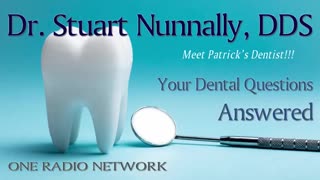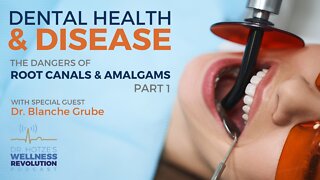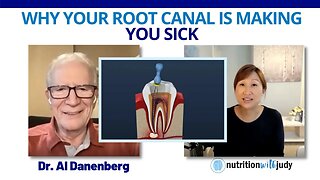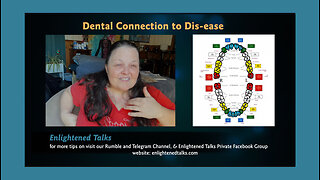Why This Dentist Refuses To Perform Root Canals
This dentist refused to perform root canals for over 20 years, here is why. For an adult, a root canal is a common procedure. It might seem like a wise choice because it helps treat and also protect any tooth that has become toxic. Thankfully, Dr. Robert Kulacz, a dentist and author of the book The Toxic Tooth: How A Root Canal Could Be Making You Sick, has done extensive research to answer the question: “Is it wise to get a root canal?”
#Dentist #RootCanal #RootCanalTherapy
Timestamps:
1 - What Is A Root Canal? 1:19
2 - Root Canal Bacteria Can Worsen Other Diseases 03:48
3 - Root Canal Teeth Can Get Infected Over Time 4:52
4 - Necrotic Tissue Can Cause Problems 05:16
5 - How to Avoid A Root Canal 05:52
6 - Brush With Toothpaste Containing Fluoride 07:27
7 - Root Canal Alternatives 07:59
8 - Extraction 08:46
9 - Dental Bridges 09:14
10 - Cantilever bridges 09:52
11 - Maryland Bridges 10:04
12 - Implant-Supported Bridges 10:14
13 -Pulp capping 10:28
Music:
https://www.youtube.com/audiolibrary/...
Summary:
let’s analyze why Dr. Kulacz has refused to perform root canals for over 20 years.
What Is A Root Canal? The Canadian Dental Association defines a root canal procedure as the process of removing infected, injured or dead pulp from a tooth. When bacteria enter your tooth through deep cavities, cracks or even flawed fillings, your tooth can become abscessed. An abscessed tooth is a tooth that has become infected with pulp. If this pulp becomes infected, doctors will recommend that it needs to be removed. If it’s not, it can cause pain and swelling.
Root Canal Bacteria Can Worsen Other Diseases: Because a root canal tooth is technically infected, it can contribute to certain health problems which include heart disease, according to Kulacz.
Root Canal Teeth Can Get Infected Over Time: Kulacz explains that because root canal teeth no longer have a blood supply, the bacteria is essentially hidden from the immune system. What’s worse is that the root canal can become more infected because of the influx of bacteria from the gum tissue that is surrounding the tooth.
Necrotic Tissue Can Cause Problems: When someone gets a root canal, the tooth is no longer alive. This means that it should never be left in your body. Take appendicitis for example; the doctor doesn’t just isolate it; he completely removes your appendix. Unfortunately, when it comes to a root canal, this rule is not applied, according to Kulacz. He adds that when patients came to him as a last resort, their chronic health issues were resolved once he removed their root canal and the infection was treated.
How to Avoid A Root Canal: According to Main Street Dental Clinics, there are a few ways you can avoid having root canal treatment. The first way is to maintain a healthy diet. According to Ramiel Nagel, the author of Cure Tooth Decay, the human body can protect itself from infection when we consume food that keeps our body balanced. According to Colgate, eliminating sugars from your diet and replacing them with fruits and vegetables also helps.
Brush With Toothpaste Containing Fluoride: The Carlson Biological Dentistry states that brushing your teeth every day with fluoride toothpaste can help scrub away the bacteria that is causing cavities. Fluoride gives your teeth extra protection against decay.
Extraction: One alternative to root canal is extraction. When a tooth is extracted, it is completely removed from a patient’s mouth. This form of treatment is not usually performed unless the tooth is so severely damaged that it cannot be saved any other way. It is often used as a last resort in the event that the tooth cannot be saved with any other type of treatment.
Dental Bridges: In the event that a dentist determines your tooth needs to be extracted, you may want to consider dental bridges. Dental bridges help to close the gap between two missing teeth. They are made of multiple crowns which are found on either side of the gap around an artificial tooth.
Cantilever bridges: These bridges are very similar to traditional bridges, but are supported by a crown on just one side.
Maryland Bridges: Maryland bridges are held in place by a piece of framework made of two wings of metal on each side of a crown.
Implant-Supported Bridges: Implant-supported bridges are used to support multiple gaps in a person’s teeth, and are supported by dental implants rather than dental crowns.
-
 5:53
5:53
FineTimer
1 year agoDent: Its All In The Details!
106 -
 50:15
50:15
HealthOdyssey
1 month agoDr. Stuart Nunnally – Biological Dentistry, Cavitations, Detoxing Mercury Fillings, Root Canal Dangers
3222 -
 24:16
24:16
Hotze Health & Wellness Center
1 year agoDental Health and Disease - The Dangers of Root Canals and Amalgams with Dr. Blanche Grube – Part 1
294 -
 45:09
45:09
International Academy of Oral Medicine & Toxicology
6 months agoFundamentals of Biological Dentistry: Root Canals/Cavitations by Griffin Cole, DDS, NMD, MIAOMT
255 -
 14:33
14:33
TheRealTruthAboutHealth
2 months agoThe Problems Associated With Root Canals, Including the Inability To Completely Sterilize the Tooth
101 -
 5:38
5:38
Nutrition with Judy
2 years agoWhy Your Root Canal is Making You Sick - Dr. Al Danenberg
44 -
 54:20
54:20
Cooperbob
1 year agoGetting rid of their dental problems with ProDentim.
16 -
 1:03:27
1:03:27
Templeton Wellness Foundation
1 month agoHow Mercury Fillings and Root Canals Could Be Making You Sick
56 -
 45:11
45:11
Relaxing songs to read, work and sleep
4 months agoDentatonic ((⛔️⚠️HIGH ALERT!!⛔️⚠️)) Dentatonic Review - Dentatonic Official - Dentatonic Review
12 -
 5:15
5:15
Enlightened Talks
1 year agoEnlightened Talks - Dental Connection to Dis-ease
65